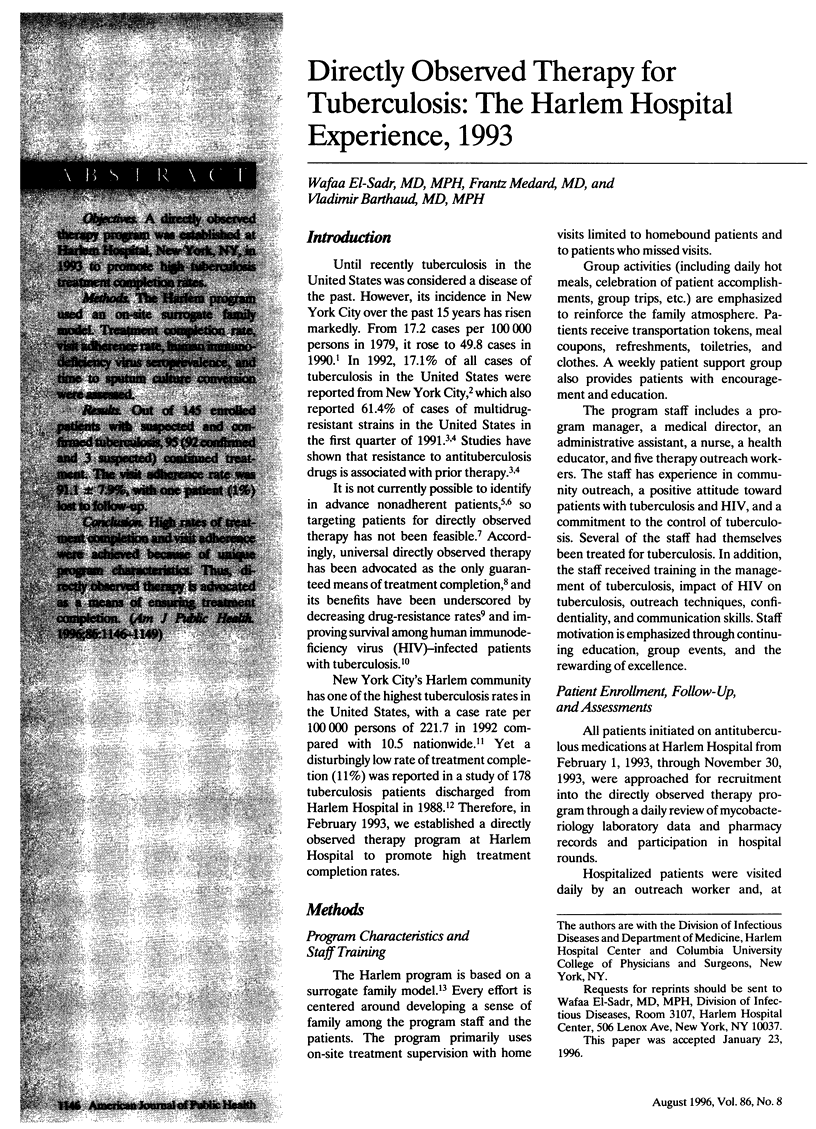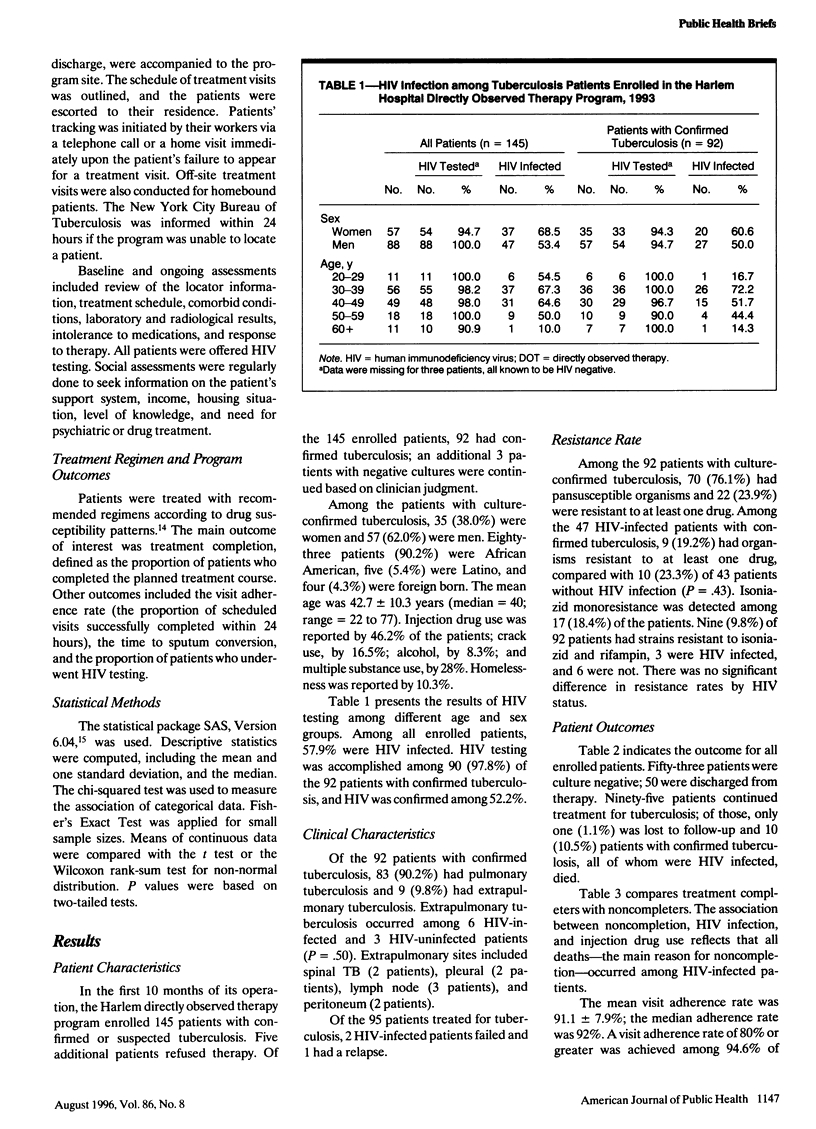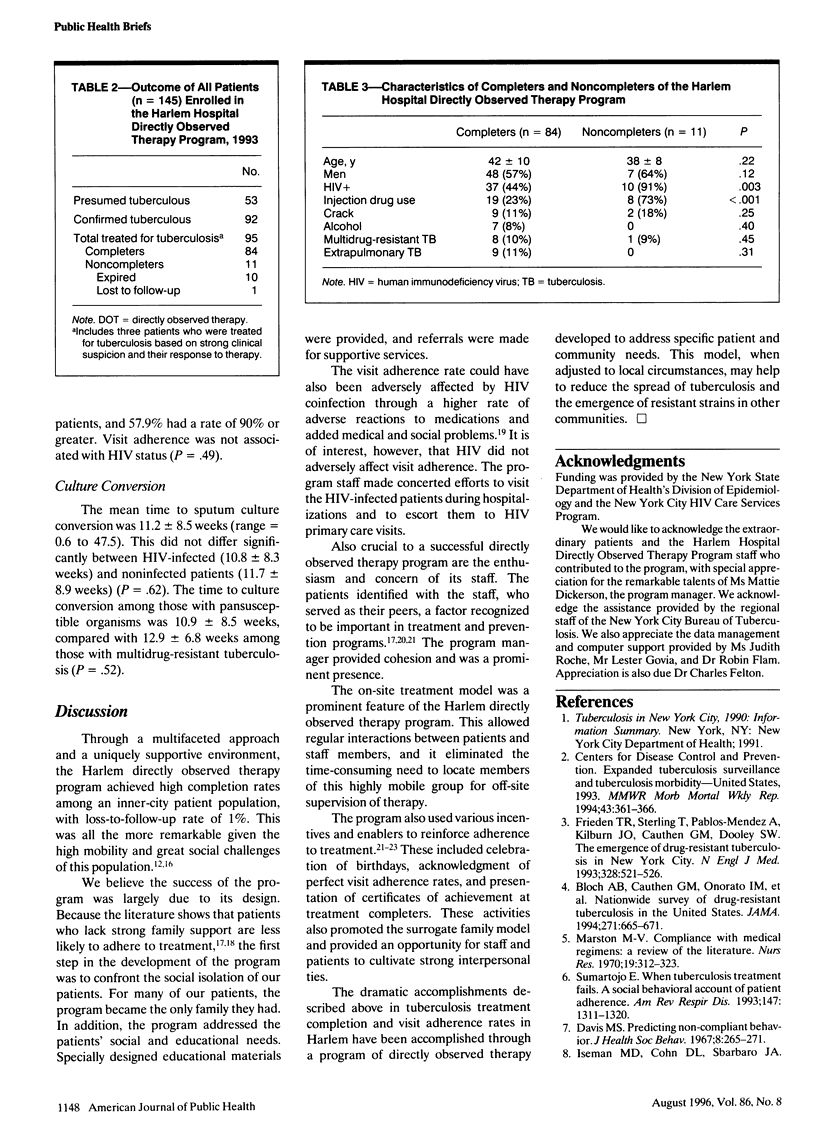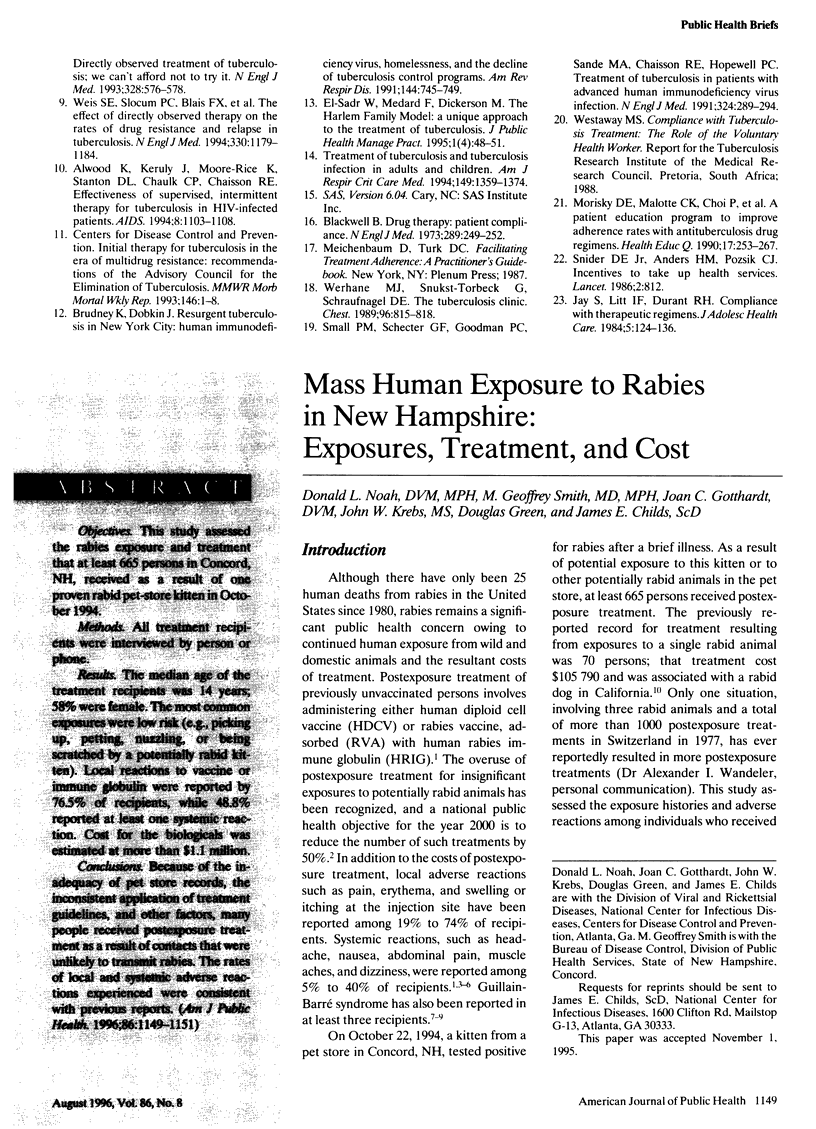Abstract
OBJECTIVES. A directly observed therapy program was established at Harlem Hospital, New York, NY, in 1993 to promote high tuberculosis treatment completion rates. METHODS. The Harlem program used an on-site surrogate family model. Treatment completion rate, visit adherence rate, human immuno-deficiency virus seroprevalence, and time to sputum culture conversion were assessed. RESULTS. Out of 145 enrolled patients with suspected and confirmed tuberculosis, 95 (92 confirmed and 3 suspected) continued treatment. The visit adherence rate was 91.1 +/- 7.9%, with one patient (1%) lost to follow-up. CONCLUSION. High rates of treatment completion and visit adherence were achieved because of unique program characteristics. Thus, directly observed therapy is advocated as a means of ensuring treatment completion.
Full text
PDF



Selected References
These references are in PubMed. This may not be the complete list of references from this article.
- Alwood K., Keruly J., Moore-Rice K., Stanton D. L., Chaulk C. P., Chaisson R. E. Effectiveness of supervised, intermittent therapy for tuberculosis in HIV-infected patients. AIDS. 1994 Aug;8(8):1103–1108. doi: 10.1097/00002030-199408000-00010. [DOI] [PubMed] [Google Scholar]
- Blackwell B. Drug therapy: patient compliance. N Engl J Med. 1973 Aug 2;289(5):249–252. doi: 10.1056/NEJM197308022890506. [DOI] [PubMed] [Google Scholar]
- Bloch A. B., Cauthen G. M., Onorato I. M., Dansbury K. G., Kelly G. D., Driver C. R., Snider D. E., Jr Nationwide survey of drug-resistant tuberculosis in the United States. JAMA. 1994 Mar 2;271(9):665–671. [PubMed] [Google Scholar]
- Brudney K., Dobkin J. Resurgent tuberculosis in New York City. Human immunodeficiency virus, homelessness, and the decline of tuberculosis control programs. Am Rev Respir Dis. 1991 Oct;144(4):745–749. doi: 10.1164/ajrccm/144.4.745. [DOI] [PubMed] [Google Scholar]
- Davis M. S. Predicting non-compliant behavior. J Health Soc Behav. 1967 Dec;8(4):265–271. [PubMed] [Google Scholar]
- Frieden T. R., Sterling T., Pablos-Mendez A., Kilburn J. O., Cauthen G. M., Dooley S. W. The emergence of drug-resistant tuberculosis in New York City. N Engl J Med. 1993 Feb 25;328(8):521–526. doi: 10.1056/NEJM199302253280801. [DOI] [PubMed] [Google Scholar]
- Jay S., Litt I. F., Durant R. H. Compliance with therapeutic regimens. J Adolesc Health Care. 1984 Apr;5(2):124–136. doi: 10.1016/s0197-0070(84)80012-1. [DOI] [PubMed] [Google Scholar]
- Marston M. V. Compliance with medical regimens: a review of the literature. Nurs Res. 1970 Jul-Aug;19(4):312–323. [PubMed] [Google Scholar]
- Morisky D. E., Malotte C. K., Choi P., Davidson P., Rigler S., Sugland B., Langer M. A patient education program to improve adherence rates with antituberculosis drug regimens. Health Educ Q. 1990 Fall;17(3):253–267. doi: 10.1177/109019819001700303. [DOI] [PubMed] [Google Scholar]
- Small P. M., Schecter G. F., Goodman P. C., Sande M. A., Chaisson R. E., Hopewell P. C. Treatment of tuberculosis in patients with advanced human immunodeficiency virus infection. N Engl J Med. 1991 Jan 31;324(5):289–294. doi: 10.1056/NEJM199101313240503. [DOI] [PubMed] [Google Scholar]
- Snider D. E., Jr, Anders H. M., Pozsik C. J., Snijder D. E., Jr Incentives to take up health services. Lancet. 1986 Oct 4;2(8510):812–812. doi: 10.1016/s0140-6736(86)90334-x. [DOI] [PubMed] [Google Scholar]
- Sumartojo E. When tuberculosis treatment fails. A social behavioral account of patient adherence. Am Rev Respir Dis. 1993 May;147(5):1311–1320. doi: 10.1164/ajrccm/147.5.1311. [DOI] [PubMed] [Google Scholar]
- Weis S. E., Slocum P. C., Blais F. X., King B., Nunn M., Matney G. B., Gomez E., Foresman B. H. The effect of directly observed therapy on the rates of drug resistance and relapse in tuberculosis. N Engl J Med. 1994 Apr 28;330(17):1179–1184. doi: 10.1056/NEJM199404283301702. [DOI] [PubMed] [Google Scholar]
- Werhane M. J., Snukst-Torbeck G., Schraufnagel D. E. The tuberculosis clinic. Chest. 1989 Oct;96(4):815–818. doi: 10.1378/chest.96.4.815. [DOI] [PubMed] [Google Scholar]
- el-Sadr W., Medard F., Dickerson M. The Harlem family model: a unique approach to the treatment of tuberculosis. J Public Health Manag Pract. 1995 Fall;1(4):48–51. [PubMed] [Google Scholar]


